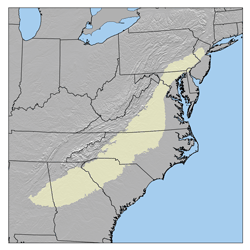Piedmont (Appalachian Mountains)
The Piedmont is a plateau-shaped region in the eastern United States of America that extends between the Atlantic coastal plain and the central section of the Appalachian mountain range . In the north-south extension, the plateau formed by the eastern capping of the Appalachians extends from the state of New Jersey to Alabama .
The Piedmont Region is part of the Appalachian Mountains and consists of the highlands, the Piedmont Highlands and the lowlands, the Piedmont Lowlands . The Fall Line , where waterfalls appear in the rivers for the first time in order to overcome the differences in altitude, describes the eastern transition between the coastal plain and the Piedmont. To the west, the Piedmont is mostly restricted by the Blue Ridge Mountains . The width of the plateau varies, starting very narrowly above the Delaware River , but reaching a width of 475 kilometers in North Carolina . The total area of the Piedmont Plateau covers about 207,000 square kilometers
The name "Piedmont" comes from French and in geography refers to a foothill zone ( pied = foot, mont = mountain). This Romanesque word root appears most prominently in the name of the Italian region of Piemonte ( Italian : Piemonte : roughly at the foot of the mountain ).
geology
The surface of the Piedmont is characterized by a gently rolling landscape, the height above sea level is between 50 meters and 250 meters to 300 meters. The geology is complex with many different rock formations made from different materials that mix with others from different ages. In essence, the Piedmont is the remnant of various very old mountain ranges that have been eroded over millions of years. Geologists have identified at least five different events in the earth's history that led to the shifting of the sedimentary layers , including the Grenville orogenesis , which also formed the continent of Rodinia , and the Appalachian orogenesis during the formation of Pangea . The last major event was the break-up of Pangea, when the American and African continents began to drift apart. Large sedimentary basins were created as a result of the division and gradually filled with the sediments given off by the surrounding higher land masses. Mesozoic sedimentary basins lined up are almost exclusively located in the Piedmont.
Floors
The soils of the Piedmont are basically loamy and moderately fertile. In some areas, the soils have suffered severely from erosion and excessive agriculture, especially in the south, where cotton was the main crop. Tobacco is the primary crop in the central Piedmont region, North Carolina and Virginia , while soils in the north are used in a variety of ways, including fruit growing , dairy farming, and general agriculture .
music
The Piedmont is very closely associated with the Piedmont Blues , a style of blues that has been native to the region since the late 19th century. Most of the musicians come from Virginia, the Carolinas and Georgia . During the great migration wave of African American residents to the north, the Piedmont Blues was influenced by many other musical styles, for example ragtime or country music , styles that had little influence on the blues in other regions.
The cakewalk or slow drag is a characteristic Piedmont dance style that is based on the local Piedmont culture.
Cities
Several larger cities have settled on the Fall Line , the eastern boundary of the plateau. Within the Piedmont itself there are a number of highly urbanized areas, for example the Piedmont Crescent , the Piedmont Crescent in North Carolina comprises several metropolitan regions , the Metrolina near Charlotte , the Research Triangle around Raleigh - Durham - Chapel Hill and the Piedmont Triad around Greensboro , Winston- Salem and High Point . Another major city on the plateau is Atlanta in the state of Georgia.
Individual evidence
- ^ US Geological Survey: Physiographic divisions of the conterminous US Last accessed December 6, 2007
- ↑ a b The Columbia Gazetteer of North America, 2000: Piedmont ( Memento of the original from March 10, 2005 in the Internet Archive ) Info: The archive link has been inserted automatically and has not yet been checked. Please check the original and archive link according to the instructions and then remove this notice. Last accessed December 9, 2007
literature
- Michael A. Godfrey: Field Guide to the Piedmont. Chapel Hill: University of North Carolina Press, 1997. ISBN 0-8078-4671-6


